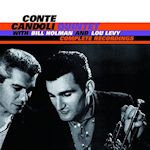“
Conte Candoli
”
1. Toots Sweet
2. Jazz City Blues
3. My Old Flame
4. Full Count
5. I’m Getting Sentimental Over You
6. Four
7. Groovin’ Higher
“
West Coast Wailers
”
8. Lover Come Back To Me
9. Comes Love
10. Lover Man
11. Pete’s Alibi
12 Cheremoya
13. Jordu
14. Flamingo
15. Marcia Lee
Conte Candoli - Trumpet
Bill Holman - Tenor sax
Lou Levy - Piano
Leroy Vinnegar - Bass
Lawrence Marable - Drums
Conte Candoli was a Dizzy Gillespie influenced hard-bop trumpeter, who began playing professionally at sixteen when he joined Woody Herman’s First Herd in
1944. Bill Holman, who eventually became better known as an imaginative composer and arranger, was at the time of these recordings in 1955, a solid
hard-swinging tenor saxophone player. Backed by a standout West Coast rhythm section, the front line delivers the goods on what is purported to be all the
material recorded by this aggregation.
The compositions that were chosen for the Conte Candoli sessions are an amalgam of originals from the two head-liners Candoli and Holman, plus
several well-known jazz themes, and a number of popular song titles. This variety offered the band the opportunity to explore the rhythmic structures of
the pieces, and to take advantage of the musical strengths of the group. The initial two tracks Toots Sweet and Jazz City Blues are
Holman tunes and are arranged with Holman’s tenor in the lead, with Candoli’s trumpet playing underneath. There is some strong solo work from Holman with Candoli’s powerhouse trumpet not far behind. Pianist Lou Levy, who had worked with Candoli in the Chubby Jackson band, has a predominantly
single-note style that adds to the dynamic of these numbers.
Conte Candoli contributes two originals in this section namely Full Count and Groovin’ Higher. In the case of
the former, Candoli has used the chord changes from I Got Rhythm to build an ascending/descending pattern that opens the door for extended solos
from Candoli, Holman and Levy. Subsequently Lawrence Marable uses his drum kit to exchange fours with Candoli and Holman. Groovin’ Higher is interesting in that, although it sounds perilously close to Dizzy Gillespie’s Groovin’ High, it is in fact based on the chord changes to Whispering. The Miles Davis tune Four opens with Lou Levy contributing an
extroverted intro, followed by the simple melodic theme which has Holman’s tenor in the lead, and again Candoli’s trumpet underneath. All the players
acquit themselves with proficiency.
West Coast Wailers
’
track list is structured slightly differently from the previous session, in that there are fewer originals and more popular standards. It starts with Lover Come Back To Me, which was written by Sigmund Romberg and Oscar Hammerstein II for the Broadway musical The New Moon in 1928. The
opening few bars are offered by Lou Levy on what seems to be a slightly out-of-tune piano (which is unusual as the original recording company was Atlantic
Records, who had a good reputation for top notch instruments). The tune shifts into a bright tempo with Candoli’s trumpet in the upper register for several
choruses. When Holman picks up the theme, he develops his interesting ideas with full force and tone. In terms of original material, Conte’s older brother
Pete has a swinger entitled Pete’s Alibi, where Conte’s big-band background serves him well as he blows up a storm. Holman
returns to writing mode with Cheremoya, which has a musical frame that is open to each band member to develop their musical ideas in a sequential
fashion.
Duke Jordan wrote Jordu which had already found favour with the Clifford Brown/Max Roach Quintet and here the band delivers its own take on the
tune. While perhaps less ambitious than the Brown/Roach version, the group shows its capacity to deliver its own aesthetic, with a clever unimpeded
approach to the number. The final track is Conte Candoli’s Marcia Lee which is a bop-infused theme with a Latin feel. With Candoli’s trumpet
taking the lead, everyone is on their game to demonstrate their versatility.
These sessions are full of a West Coast hard-bop feel, amplifying a regret that this is all there is.
Pierre Giroux
